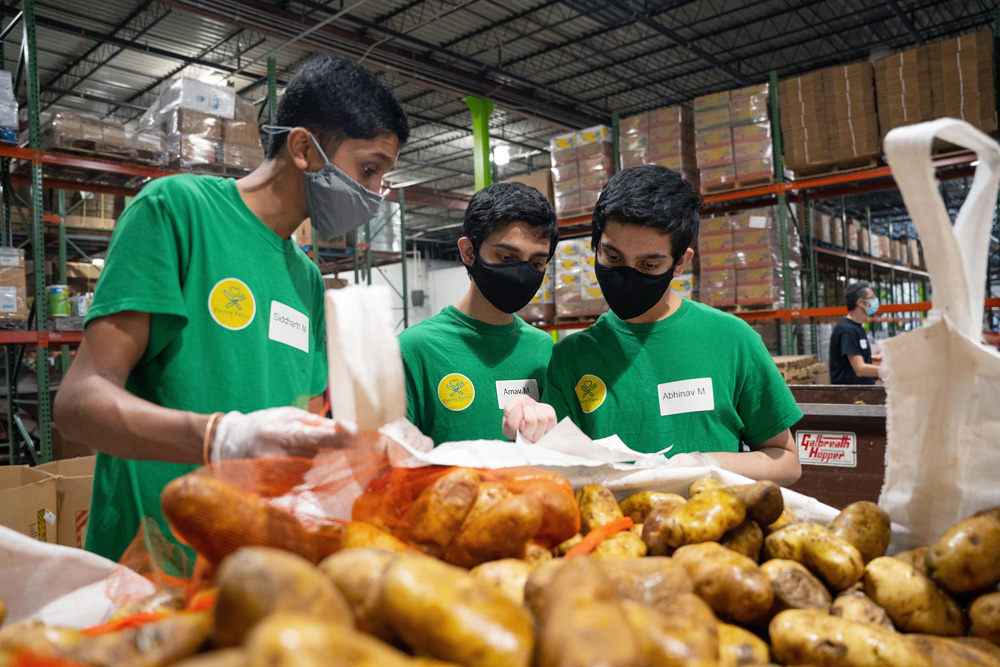With a passion for technology, a drive to make a real-world impact in their community, and some help from UNC-Chapel Hill researchers, three local high school students created Pantry Patrol, a user-friendly application designed to help food pantries better combat hunger.
One in six Americans are food insecure, yet 40 percent of food produced in the United States is wasted every year. With the help of UNC Center for Health Promotion and Disease Prevention Director Alice Ammerman and local food bank experts, three high school students are working to change that.

Siddharth Maruvada, Arnav Meduri, and his twin brother Abhinav Meduri are sophomores at Enloe Magnet High School in Raleigh. In July 2020, they began working with Ammerman to create what would become known as Pantry Patrol, an award-winning app designed to minimize food waste at food pantries and banks.
After winning regional and state rounds of eCybermission, a web-based STEM competition for sixth through ninth graders, the team went on to nationals and placed first in their ninth-grade category.
“There’s this huge disconnect between people needing food and food being thrown away,” says Ammerman, adding that inefficient food labeling systems and overly cautious expiration dating are factors exacerbating the issue.
After discovering Ammerman’s research interests in food insecurity, the team reached out to seek her guidance in developing a product that could make a real impact. Ammerman supplied the three ninth graders with a list of reading materials to help them become better acquainted with the main components and challenges surrounding food waste.
“We wanted to do something that could help the community and lend a hand in any way that we could during these difficult times. That was our main driver behind developing this application,” Maruvada says.
Ammerman provided more than just literature and expertise on the subject, though. Through her community connections with the North Carolina Local Food Council, the Pantry Patrol team began collaborating with the people fighting food insecurity on the front lines: food bank leaders and food pantry workers.
Gideon Adams and Angie Nesius are two of those individuals. Adams, who is also a member of the North Carolina Local Food Council with Ammerman, serves on the leadership board for the Food Bank of Central & Eastern North Carolina as the vice president of community health and engagement.
“[The students’] real power for me was how they would interpret human impact and that practical nuance into data,” Adams says. “I felt really comfortable sharing what I had seen and experienced working in the field and immediately felt that they would not only get it but be able to translate it.”
Working closely with Adams and Nesius enabled the team to tailor the Pantry Patrol app to best fit the food pantries’ needs. They started by developing food waste focused tools, which resulted in features like food waste dashboards, food inspections, and customizable data visualizations that allow the food pantries to determine when and how food waste is actually happening in their systems.
They soon realized helping the pantries transition away from pencil-and-paper methods of record keeping could improve their efficiency, too. So they began incorporating features like clients’ food sensitivities, preferences, and allergies; a system to track volunteer hours; and other food pantry management tools in the app design.
“There are just so many different ways that this can impact our network,” says Nesius, the data and record collection coordinator at the Food Bank of Central & Eastern North Carolina’s Raleigh branch. “For example, we often receive grants to fund freezers and refrigerators that we can pass on to our partners. If we find that some foods are being thrown out because the pantry does not have the ability to freeze excess perishables, then this might be a way for us to identify which partner agencies we should target with the freezers funded through grants.”
The app is currently being used by two North Carolina food pantries in Spring Hope and Roxboro, North Carolina. The team hopes to roll out the application to about 15 food pantries by the end of the year.
“These kids are going to, hopefully, inspire others,” Adams says. “The fact that we have such a close connection with Alice and with UNC shows how beneficial those relationships are, and if they’re beneficial for us they’ll be beneficial for other people as well.”
Alice Ammerman is the director of the UNC Center for Health Promotion and Disease Prevention and the Mildred Kaufman Distinguished Professor in the Department of Nutrition within the UNC Gillings School of Global Public Health.
Gideon Adams is the vice president of community health and engagement at the Food Bank of Eastern and Central Carolina.
Angie Nesius is a data and record collection coordinator at the Raleigh branch of the Food Bank of Eastern and Central Carolina.
